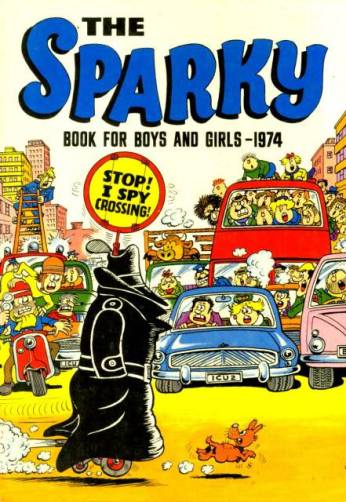Introduction
The Comic Creators Project at the Cartoon Museum in London has original artwork from I Spy, a novelty strip where the hero was a secret agent who wore a long trench coat which concealed hundreds of weapons and gadgets (similar to a character from Smash! called The Cloak and a definite forerunner of Inspector Gadget).

I Spy made its first appearance in Sparky #211 (1969). Sparky was a British comic that was published weekly by DC Thomson. It ran from 23 January 1965 to 9 July 1977 when it merged with The Topper after 652 issues. This comic was originally aimed at a slightly younger audience to DC Thomson’s The Beano and The Dandy, but later on it was aimed at the same public. In 1973, it changed its name to The Sparky Comic (Wikipedia). By then, I Spy had been running for quite a while with its last episode seeing the light in 1976 (#586).
The scripts were written by Peter Clark, who later became editor-in-chief of Warlord in the mid-70s (“I -Spy” 2010). As with many titles, I Spy was drawn by several artists. The first issues were created by Les Barton between 1969 and 1970. He drew over 60 episodes, and his work is generally regarded as the peak of creativity of the whole series (“I-Spy” 2010)-including the novelty of creating one of the first serialized humour strips in British comics. From 1970 to 1972 Brian Walker took over, staying close to the style already developed by Les Barton but bringing a more energetic feel to the artwork and page layouts. Then towards 1971, the strip went from black and white to full colour with mostly shorter-length stories. John Fox was the last artist who took on the strip from 1974 to 1976, before it was briefly resurrected for a complete story in Fun-Size Dandy No. 63, in 2000, which was drawn by Lew Stringer.

The early strips appeared in single pages with a clear novelty feel to them. The format then evolved into a cloak and dagger themed melodrama with plenty of comical humour. The format of the strip was also upgraded soon enough to a double-spreader, which allowed the artists more space to develop the story (“I-Spy” 2010). This spy-saga was viewed by true fans as an “exciting series of comic thrills and adventure spills, not often seen within the traditional confines of ‘cartoon’-dominated comics.” (“I-Spy” 2010)
Regrettably, the early I Spy material has never been widely seen since it was first published. There have been no reprints or special editions, except for the strip’s return in Champ Comic 1984-85 . Therefore, this very impressive comics material remains only in the memories of those who read Sparky religiously when it came out, or to the lucky few who have access to the full run of the original comics.
I-Spy

As already mentioned, I Spy himself was a secret agent whose features were never seen at all by readers: his face was completely hidden by an oversize trilby hat and an upturned, oversize trench coat. The trench coat housed a never-ending array of baffling weaponry and artillery that extended easily from within his all-black spy-suit and that he operated by pushing the buttons located in his pockets. Despite his mysterious look, I Spy himself appeared to be human. In some instances, he abandoned his still-standing suit, but his greatest advantage came from his unlimited gadgetry, which enabled him to fly or to assemble a tank-like defense with caterpillar included, just to give a couple of examples.
 I Spy’s greatest foes in the early numbers were Slinky Snitchovitch, of Soviet origin, and Karate Chip, of Oriental origin, which reflected in a way the political climate of the time. Their despicable ambitions were usually concerned with ‘lobbing a black anarchist bomb’ somewhere, to much comical effect. Not long after, the writer introduced more elaborate schemes by the increasingly desperate villains, leading to the creation of Mr. X in issue 217, one of I Spy’s most formidable adversaries and a more long-lasting evildoer. Mr. X was a demented charlatan who would stop at nothing in his quest for World Domination. He usually appeared in Victorian attire with a shiny top hat, a flowing black cape and a permanent cigar with its holder. Mr. X did not seem to be a rich man, which meant that he depended on his wits alone to defeat his nemesis, I Spy–whom he needed to remove before his plans could be finalized. At one point, Mr. X’s hideout, a rundown Gothic castle, was blown up by the madman himself in a failed attempt to destroy I Spy with a booby-trap that was set off with explosives. Later on, the colour series introduced a variety of very stereotypical villains, many of whom bordered on jingoistic foreign-types.
I Spy’s greatest foes in the early numbers were Slinky Snitchovitch, of Soviet origin, and Karate Chip, of Oriental origin, which reflected in a way the political climate of the time. Their despicable ambitions were usually concerned with ‘lobbing a black anarchist bomb’ somewhere, to much comical effect. Not long after, the writer introduced more elaborate schemes by the increasingly desperate villains, leading to the creation of Mr. X in issue 217, one of I Spy’s most formidable adversaries and a more long-lasting evildoer. Mr. X was a demented charlatan who would stop at nothing in his quest for World Domination. He usually appeared in Victorian attire with a shiny top hat, a flowing black cape and a permanent cigar with its holder. Mr. X did not seem to be a rich man, which meant that he depended on his wits alone to defeat his nemesis, I Spy–whom he needed to remove before his plans could be finalized. At one point, Mr. X’s hideout, a rundown Gothic castle, was blown up by the madman himself in a failed attempt to destroy I Spy with a booby-trap that was set off with explosives. Later on, the colour series introduced a variety of very stereotypical villains, many of whom bordered on jingoistic foreign-types.
Other common elements found throughout the whole series were Boss Spy and Spy HQ. For I Spy to get a mission, a boss was required. This Boss appeared to be very authoritarian in the beginning, well respected as a member of the mysterious Spy organization. He usually appeared behind a desk barking orders to I Spy (this could be in person on through the radio waves). Once the first proper serial came out, Boss changed to a middle-aged man who loved 60s “cool” black shades. When I Spy met with Boss in HQ these were never in the same place. The place seemed to be constantly changing, from a fortified stronghold, to a impressive detached house, a place away in the country, or a block of apartments in Central London.
Further Reading
Gray, Peter. 2008. “I-Spy by Brian Walker Sparky 1972 onwards” in Peter Gray’s Comics. Accessed July 17, 2016.
“I-Spy.” 2010. Wikia: The Home of Fandom. Accessed July 16, 2016.
“I Spy….The First Epic Serial.” 2007. Comics UK. Accessed September 5, 2016.
“I. Spy – the `years of decline, Sparky & Champ.” 2008. Comics UK. Accessed September 5, 2016.
“Sparky Comics“. Wikipedia. Accessed July 16, 2016.
Credits
We would like to thank the Heritage Lottery Fund for supporting our work at the Comic Creators Project.

*All images and characters that appear in this site are copyright of their respective holders, and are used for informational purposes only. No copyright infringement is intended.





September 8, 2016 at 1:56 pm
Whatever you do, do NOT give that original artwork to the BBC for safeguarding.
LikeLike
November 1, 2016 at 8:57 am
I’ve seen it observed before that, whereas the spy boom in the cinema and on TV in the 1960s shed the inter-war look of trenchcoat and trilby in favour of sharp suits and dinner jackets, the comic and comedy versions obstinately retained the older iconography – see not just “I, Spy” here, but also “Eagle Eye, Junior Spy”, “The Cloak”, Mad magazine’s “Spy vs Spy” and so on. So here we have a hero with 1960s gadgetry and 1930s clothes facing a villain from the 1910s. How, I wonder, did a child of 1969, more used to “The Man from UNCLE” than “The 39 Steps” or “The Third Man”, receive that?
LikeLike